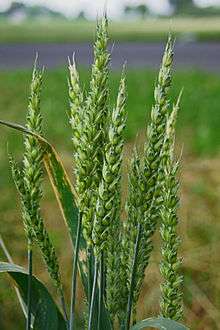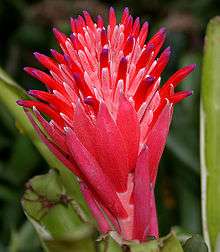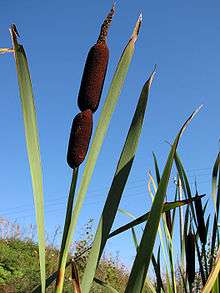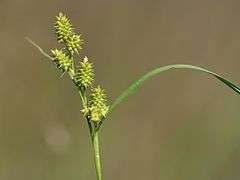Poales
| Poales Temporal range: Late Cretaceous - Recent (but see text) 66–0 Ma | |
|---|---|
 | |
| Common wheat (Triticum aestivum) | |
| Scientific classification | |
| Kingdom: | Plantae |
| Clade: | Angiosperms |
| Clade: | Monocots |
| Clade: | Commelinids |
| Order: | Poales Small[1] |
| Families | |
|
See text | |
The Poales are a large order of flowering plants in the monocotyledons, and includes families of plants such as the grasses, bromeliads, and sedges. Sixteen plant families are currently recognized by botanists to be part of Poales.
Description

The flowers are typically small, enclosed by bracts, and arranged in inflorescences (except in the genus Mayaca, with solitary terminal flowers). The flowers of many species are wind pollinated; the seeds usually contain starch.
Taxonomy
The APG III system (2009) accepts the order within a monocot clade called commelinids, and accepts the following 16 families:[1]
The earlier APG system (1998) adopted the same placement of the order, although it used the spelling "commelinoids". It did not include the Bromeliaceae and Mayaceae, but had the additional families Prioniaceae (now included in Thurniaceae), Sparganiaceae (now in Typhaceae), and Hydatellaceae (now transferred out of the monocots; recently discovered to be an 'early-diverging' lineage of flowering plants).
The morphology-based Cronquist system did not include an order named Poales, assigning these families to the orders Bromeliales, Cyperales, Hydatellales, Juncales, Restionales and Typhales.
In early systems, an order including the grass family did not go by the name Poales but by a descriptive botanical name such as Graminales in the Engler system (update of 1964) and in the Hutchinson system (first edition, first volume, 1926), Glumiflorae in the Wettstein system (last revised 1935) or Glumaceae in the Bentham & Hooker system (third volume, 1883).
Evolution and phylogeny
The earliest fossils attributed to the Poales date to the late Cretaceous period about 66 million years ago, though some studies (e.g., Bremer, 2002) suggest the origin of the group may extend to nearly 115 million years ago, likely in South America. The earliest known fossils include pollen and fruits.
The phylogenetic position of Poales within the commelinids was difficult to resolve, but an analysis using complete chloroplast DNA found support for Poales as sister group of Commelinales plus Zingiberales.[2] Major lineages within the Poales have been referred to as bromeliad, cyperid, xyrid, graminid, and restiid clades. A phylogenetic analysis resolved most relationships within the order but found weak support for the monophyly of the cyperid clade.[3] The relationship between Centrolepidaceae and Restoniaceae within the restiid clade remains unclear; the first may actually be embedded in the latter.[3][4]
| |
| |||||||||||||||||||||||||||||||||||||||||||||||||||||||||||||||||||||||||||||||||||||||||||||
| | ||||||||||||||||||||||||||||||||||||||||||||||||||||||||||||||||||||||||||||||||||||||||||||||
| Poales |
| |||||||||||||||||||||||||||||||||||||||||||||||||||||||||||||||||||||||||||||||||||||||||||||
| |
Diversity
The four most species-rich families in the order are:
- Poaceae: 12,070 species
- Cyperaceae: 5,500 species
- Bromeliaceae: 3,170 species
- Eriocaulaceae: 1,150 species
- Diversity of Poales
 Typha latifolia, Typhaceae
Typha latifolia, Typhaceae Carex demissa, Cyperaceae
Carex demissa, Cyperaceae- Xyris complanata, Xyridaceae
- Elegia capensis, Restionaceae
 Foxtail millet, Poaceae
Foxtail millet, Poaceae
Uses
The Poales are the most economically important order of monocots and possibly the most important order of plants in general. Within the order, by far the most important family economically is the family of grasses (Poaceae, syn. Gramineae), which includes barley, maize, millet, rice, and wheat. Many Bromeliaceae are used as ornamental plants.
References
| Wikimedia Commons has media related to Poales. |
| Wikispecies has information related to: Poales |
- 1 2 Angiosperm Phylogeny Group (2009). "An update of the Angiosperm Phylogeny Group classification for the orders and families of flowering plants: APG III" (PDF). Botanical Journal of the Linnean Society. 161 (2): 105–121. doi:10.1111/j.1095-8339.2009.00996.x. Retrieved 2013-07-06.
- ↑ Barrett, Craig F.; Baker, William J.; Comer, Jason R.; Conran, John G.; Lahmeyer, Sean C.; Leebens-Mack, James H.; Li, Jeff; Lim, Gwynne S.; Mayfield-Jones, Dustin R.; Perez, Leticia; Medina, Jesus; Pires, J. Chris; Santos, Cristian; Wm. Stevenson, Dennis; Zomlefer, Wendy B.; Davis, Jerrold I. (2015). "Plastid genomes reveal support for deep phylogenetic relationships and extensive rate variation among palms and other commelinid monocots" (PDF). New Phytologist: n/a–n/a. doi:10.1111/nph.13617. ISSN 0028-646X.
- 1 2 Bouchenak-Khelladi, Yanis; Muasya, A. Muthama; Linder, H. Peter (2014). "A revised evolutionary history of Poales: origins and diversification". Botanical Journal of the Linnean Society. 175 (1): 4–16. doi:10.1111/boj.12160. ISSN 0024-4074.

- ↑ Briggs, Barbara G.; Marchant, Adam D.; Perkins, Andrew J. (2014). "Phylogeny of the restiid clade (Poales) and implications for the classification of Anarthriaceae, Centrolepidaceae and Australian Restionaceae". Taxon. 63 (1): 24–46. doi:10.12705/631.1. ISSN 0040-0262.
- Bremer, K. (2002). Gondwanan Evolution of the Grass Alliance of Families (Poales). Evolution 56: 1374-1387. [Available online: Abstract ]
- Judd, W. S., C. S. Campbell, E. A. Kellogg, P. F. Stevens, M. J. Donoghue (2002). Plant Systematics: A Phylogenetic Approach, 2nd edition. pp. 276–292 (Poales). Sinauer Associates, Sunderland, Massachusetts. ISBN 0-87893-403-0 .
- Linder, H. Peter and Paula J. Rudall. 2005. Evolutionary History of the Poales. Annual Review of Ecology, Evolution, and Systematics 36: 107-124.
- Small, J. K. (1903). Flora of the Southeastern United States, 48. New York, U.S.A.